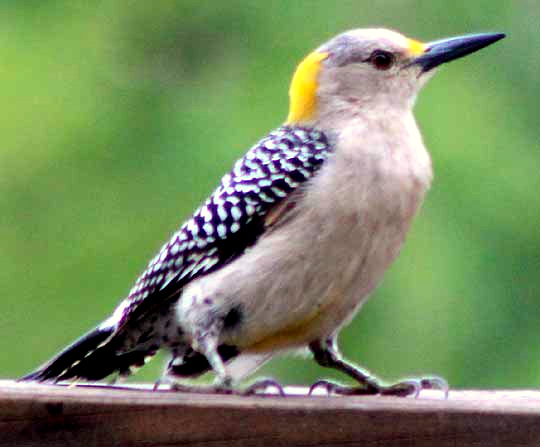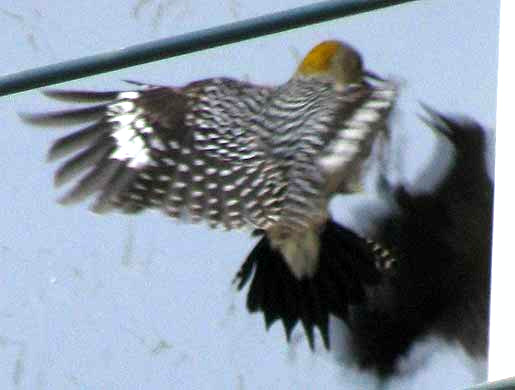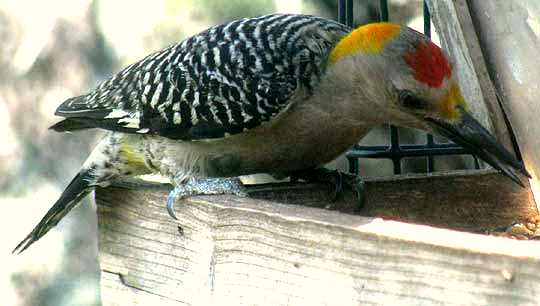Excerpts from Jim Conrad's
Naturalist Newsletter
from the June 1, 2014 Newsletter issued from the Frio Canyon Nature Education Center in the valley of the Dry Frio River in northern Uvalde County, southwestern Texas, on the southern border of the Edwards Plateau; elevation ~1750m (~5750 ft); N29.62°, W99.86°; USA
FEMALE GOLDEN-FRONTED WOODPECKER DEFENDING TERRITORY
Each morning on most days in March and April both male and female of a pair of Golden-fronted Woodpeckers took turns attacking their own images in windows at my neighbor Phred's house. They were programmed to defend their territories from other woodpeckers of their species, and their reflections in the windows triggered their attacks. The window banging stopped during most of May, but this week they started up again, and I wonder if the return of rain had anything to do with it. Below you can see Phred's picture of the female on the balcony guardrail beside the couple's favorite attacking window:

My picture showing the female attacking her own reflection is below:

It was a little surprising to see a female so actively defending territory, because in most songbird species that's the male's chore. Female Cardinals sometimes do the same thing, though, and female aggression in Golden-fronteds is well documented. In Michael Husak's study "Seasonal variation in Territorial Behavior of Golden-fronted Woodpeckers in West-Central Texas," in the March, 2000 edition of the The Southwestern Naturalist, I read:
"Intrasexual aggression was regularly observed between non-mated individuals, including males instigating attacks upon intruding females and females instigating attacks upon intruding males."
Golden-fronted Woodpeckers occur from Nicaragua north through Mexico to the brushlands of Texas and Oklahoma. They look a lot like eastern North America's common Red-bellied Woodpecker, except that the Golden-fronted male displays less color on the head. In the Yucatan this was one of our most commonly encountered birds. We show them pecking at anonas and papayas at http://www.backyardnature.net/yucatan/wp-g-f.htm.
On that page you might notice that Yucatan birds have red on their heads, not yellow. That's because Golden-fronted Woodpeckers are represented by four subspecies that differ in size, amount of barring on the tail, and the color of the nape, nasal tufts, and belly. You can see that the nape of our Texas birds -- and on Golden-fronteds in most of Mexico as well -- is yellow to orange, while it's red on Yucatan birds, and orange farther south. The four forms were formerly considered different species. The Gila Woodpecker mostly of northwestern Mexico shows a different combination, and sometimes has been lumped with the Golden-fronted species. My own personal feeling is that all these variations probably would be best treated as one species, along with the East's Red-bellied Woodpecker.
from the June 22, 2014 Newsletter issued from the Frio Canyon Nature Education Center in the valley of the Dry Frio River in northern Uvalde County, southwestern Texas, on the southern border of the Edwards Plateau; elevation ~1750m (~5750 ft); N29.62°, W99.86°; USA
HEAD COLORS OF MALE GOLDEN-FRONTED WOODPECKER
Male Golden-fronted Woodpeckers display different color patterns on their heads from the females, plus the patterns change from subspecies to subspecies across the species' extensive distribution. Steve Howell adds in his A Guide to The Birds of Mexico and Northern Central America that the different subspecies are linked by "... variably intermediate populations."
Therefore, it can be interesting to know exactly what head-color pattern our male Golden-fronted Woodpeckers display. It happens that lately a couple of Golden-fronteds has been visiting our feeder, so below you can see exactly what color pattern our local males display:

The nape and nasal tufts are yellow, but the crown patch is red. This is the combination described as typical of the subspecies aurifrons, which is the subspecies occurring in the US and northern and central Mexico. Other subspecies display different patterns.
Despite this being what's expected for our subspecies, somehow it's gratifying to confirm that in our little corner of the woodpecker world head colors pan out exactly as advertised.